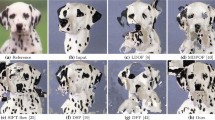Abstract
Speeded up robust feature (SURF) is one of the most popular feature-based algorithms handling image matching. Compared to emerging deep learning neural network-based image matching algorithms, SURF is much faster with comparable accuracy. Currently, it is still one of the dominant algorithms adopted in majority of real-time applications. With the increasing popularity of video-based computer vision applications, image matching between an image and different frames of a video stream is required. Traditional algorithms could fail to deal with live video because spatiotemporal differences between frames could cause significant fluctuation in the results. In this study, we propose a self-adaptive methodology to improve the stability and precision of image–video matching. The proposed methodology dynamically adjusts threshold in feature points extraction to control the number of extracted feature points based on the content of the previous frame. Minimum ratio of distance (MROD) matching is integrated to preclude false matches while keeping abundant sample sizes. Finally, multiple homography matrix (H-Matrix) are estimated using progressive sample consensus (PROSAC) with various reprojection errors. The model with lowest mean square error (MSE) will be selected for image-to-video frame matching. The experimental results show that the self-adaptive SURF offers more accurate and stable results while balancing single frame processing time in image-video matching.

















Similar content being viewed by others
Availability of data and materials
Available upon request.
References
Shapiro, L.S., Michael Brady, J.: Feature-based correspondence: an eigenvector approach. Image Vis. Comput. 10(5), 283–288 (1992). https://doi.org/10.1016/0262-8856(92)90043-3
Lowe, D.G.: Distinctive image features from scale-invariant keypoints. Int. J. Comput. Vis. 60(2), 91–110 (2004). https://doi.org/10.1023/B:VISI.0000029664.99615.94
Bay, H., Tuytelaars, T., Van Gool, L.: SURF: speeded up robust features. In: Leonardis, A., Bischof, H., Pinz, A. (eds.) Computer vision—ECCV 2006, vol. 3951, pp. 404–417. Springer, Berlin, Heidelberg (2006)
Li, Z., Dong, Z., Yu, A., He, Z., Zhu, X., et al.: A robust image sequence registration algorithm for videosar combining surf with inter-frame processing. IEEE Conference Publications (2020). https://ieeexplore.ieee.org/document/8899848
Zhang, Y., Yang, L., Wang, Z., et al.: Research on video image stitching technology based on SURF (2020). https://ieeexplore.ieee.org/document/6406008
Sarlin, P.-E., DeTone, D., Malisiewicz T., Rabinovich, A.: SuperGlue: learning feature matching with graph neural networks. In: 2020 IEEE/CVF Conference on Computer Vision and Pattern Recognition (CVPR) (2020). https://doi.org/10.1109/CVPR42600.2020.00499. https://ieeexplore.ieee.org/document/9157489. Accessed 01 Jan 2023
Sun, J., Shen, Z., Wang, Y., Bao, H., Zhou, X.: LoFTR: detector-free local feature matching with transformers. In: 2021 IEEE/CVF Conference on Computer Vision and Pattern Recognition (CVPR) (2021). https://doi.org/10.1109/CVPR46437.2021.00881. https://ieeexplore.ieee.org/document/9578008. Accessed 01 Jan 2023
Cantzler, H.: Random sample consensus (RANSAC). Institute for Perception, Action and Behaviour, Division of Informatics, Univ. of Edinburgh (1981). http://citeseerx.ist.psu.edu/viewdoc/download?doi=10.1.1.106.3035&rep=rep1&type=pdf
Chum, O., Matas, J.: Matching with PROSAC—progressive sample consensus. In: 2005 IEEE Computer Society Conference on Computer Vision and Pattern Recognition (CVPR’05), San Diego, CA, USA, 2005, vol. 1, pp. 220–226. https://doi.org/10.1109/CVPR.2005.221
Funding
No funding was received to assist with the preparation of this manuscript.
Author information
Authors and Affiliations
Contributions
Authors’ contributions are in the same order as the order of author list. Dr. Ming Yang proposed the idea and directed the research. Mr. Jiaming Li implemented the experiments and collected the results. Dr. Zhigang Li helped with data collection/analysis and paper writing. Mr. Wen Li helped with the implementation and results collection. Mr. Kairui Zhang helped with the implementation and results collection. All authors reviewed the manuscript.
Corresponding author
Ethics declarations
Conflict of interest
The authors have no relevant financial or non-financial interests;
Ethical approval
Not applicable;
Additional information
Publisher's Note
Springer Nature remains neutral with regard to jurisdictional claims in published maps and institutional affiliations.
Rights and permissions
Springer Nature or its licensor (e.g. a society or other partner) holds exclusive rights to this article under a publishing agreement with the author(s) or other rightsholder(s); author self-archiving of the accepted manuscript version of this article is solely governed by the terms of such publishing agreement and applicable law.
About this article
Cite this article
Yang, M., Li, J., Li, Z. et al. Self-adaptive SURF for image-to-video matching. SIViP 18, 751–759 (2024). https://doi.org/10.1007/s11760-023-02802-w
Received:
Revised:
Accepted:
Published:
Issue Date:
DOI: https://doi.org/10.1007/s11760-023-02802-w




